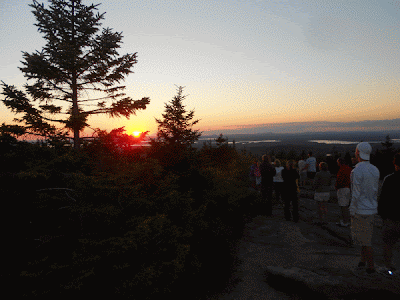Acadia National Park in Maine is a great place for hiking and I just wanted to post a description of a nice one that I can highly recommend if you're ever in the area. It's a hike down Cadillac Mountain. I know that's a wimpy thing to do, most people will hike up mountains, but my kids weren't up for that. My wife to drove us up to the top and then we took the North Ridge Trail back down. It was a nice, relatively easy, hike.
My 12-year-old daughter looking cool atop a glacial erratic
The hike starts at the parking lot at the top of Cadillac. A stunningly beautiful place with a 360° panorama of Mt Desert Island, the mountains of mainland Maine (including Katahdin) off in the distance, surrounding islands, and (of course) the Atlantic Ocean.
The hike had nice views of Frenchman's Bay most of the way down.
I was surprised at all of the lichens on the pink granitic bedrock. Not that the lichens existed, but that they persisted despite the endless stream of hiker's boots trampling all over them. They certainly are hardy and add a nice dash of orange, green, and gray to the pink rock.
Lichens truly are beautiful (and interesting too - I wish I knew more about them).
In many places, the granitic bedrock was heavily jointed (and colonized by vegetation). This type of orthogonal jointing (two sets of fractures at right angles to each other) is common in granite. The rock was emplaced as magma and cooled underground under confining pressure. Later, when eroded to the surface, the pressure is released and the rock expands slightly in all directions forming these joint sets.
The Cadillac Mountain Granite is a pink granite - pink being potassium (K) feldspar with some white sodium plagioclase feldspar, glassy quartz, and black hornblende and biotite mica. These granites are part of what's called the Cadillac Mountain Intrusive Complex (CMIC) and zircon crystals from the granites give U-Pb ages of around 420 Ma. Other mineralogical and geochemical evidence suggests relatively shallow emplacement (5-7 km).
These rocks were intruded as a microcontinent called Avalonia (as called Avalon) collided with proto-North America (called Laurentia by geologists) during an event called the Acadian Orogeny (an orogeny is a mountain-building event). That's a whole long story in itself which I'll hold off on for now!
In places, the Cadillac Mountain Granite is intruded by igneous (diabase) dikes as this famous example found on the side of the road to the top of Cadillac shows.
Cairns made it impossible to miss the trail on the exposed bedrock (there were signs for people not to mess with cairns because some idiots apparently think they're decorative and rearrange them such that others get led astray!).
The large birds overhead were, I believe, peregrine falcons.
And it was nice to enjoy wild Maine blueberries right off the bushes.












No comments:
Post a Comment